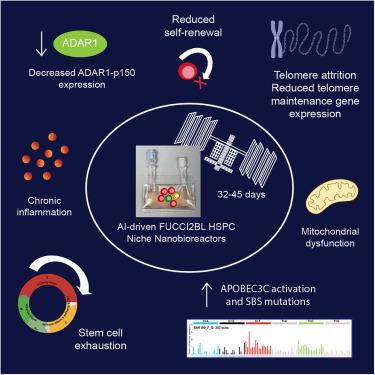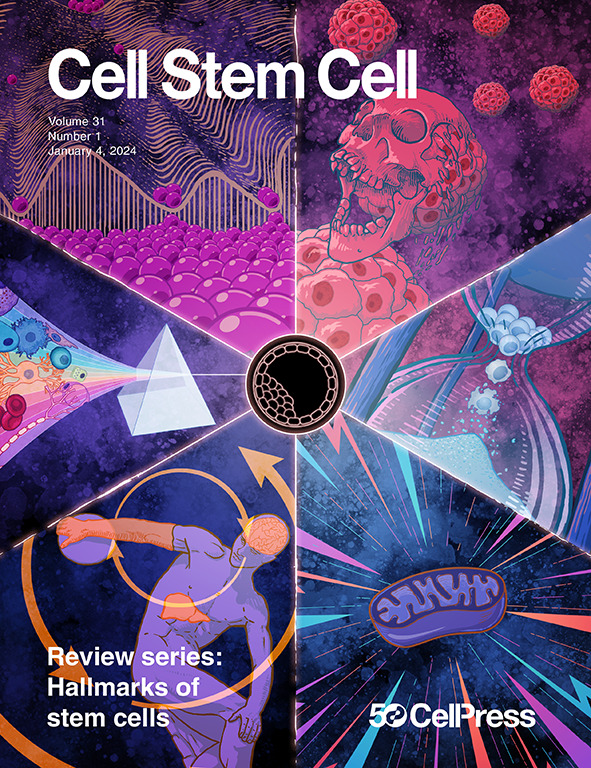Nanobioreactor detection of space-associated hematopoietic stem and progenitor cell aging
IF 20.4
1区 医学
Q1 CELL & TISSUE ENGINEERING
引用次数: 0
Abstract
Human hematopoietic stem and progenitor cell (HSPC) fitness declines following exposure to stressors that reduce survival, dormancy, telomere maintenance, and self-renewal, thereby accelerating aging. While previous National Aeronautics and Space Administration (NASA) research revealed immune dysfunction in low-earth orbit (LEO), the impact of spaceflight on human HSPC aging had not been studied. To study HSPC aging, our NASA-supported Integrated Space Stem Cell Orbital Research (ISSCOR) team developed bone marrow niche nanobioreactors with lentiviral bicistronic fluorescent, ubiquitination-based cell-cycle indicator (FUCCI2BL) reporter for real-time HSPC tracking in artificial intelligence (AI)-driven CubeLabs. In month-long International Space Station (ISS) missions (SpX-24, SpX-25, SpX-26, and SpX-27) compared with ground controls, FUCCI2BL reporter, whole-genome and transcriptome sequencing, and cytokine arrays demonstrated cell-cycle, inflammatory cytokine, mitochondrial gene, human repetitive element, and apolipoprotein B mRNA editing enzyme, catalytic polypeptide-like 3 (APOBEC3) deregulation together with clonal hematopoietic mutations. Furthermore, HSPC functionally organized multi-omics aging (HSPC-FOMA) analyses revealed reduced telomere maintenance, adenosine deaminase acting on RNA1 (ADAR1) p150 self-renewal gene expression, and replating capacity indicative of space-associated HSPC aging that may limit long-duration spaceflight.

纳米生物反应器检测空间相关造血干细胞和祖细胞衰老
人类造血干细胞和祖细胞(HSPC)适应性在暴露于减少生存、休眠、端粒维护和自我更新的压力源后下降,从而加速衰老。虽然美国国家航空航天局(NASA)之前的研究揭示了低地球轨道(LEO)中的免疫功能障碍,但太空飞行对人类HSPC衰老的影响尚未得到研究。为了研究HSPC老化,我们的nasa支持的集成空间干细胞轨道研究(ISSCOR)团队开发了骨髓生态位纳米生物反应器,该反应器具有慢病毒双电子荧光、基于泛素化的细胞周期指示器(FUCCI2BL)报告器,用于在人工智能(AI)驱动的CubeLabs中实时跟踪HSPC。在为期一个月的国际空间站(ISS)任务(SpX-24、SpX-25、SpX-26和SpX-27)中,与地面对照组相比,FUCCI2BL报告基因、全基因组和转录组测序以及细胞因子阵列显示细胞周期、炎症细胞因子、线粒体基因、人类重复元件、载脂蛋白B mRNA编辑酶、催化多肽样3 (APOBEC3)解除调控以及克隆造血突变。此外,HSPC功能组织的多组学老化(HSPC- foma)分析显示,端粒维持减少,腺苷脱氨酶作用于RNA1 (ADAR1) p150自我更新基因表达,复制能力表明与太空相关的HSPC老化可能限制长时间的太空飞行。
本文章由计算机程序翻译,如有差异,请以英文原文为准。
求助全文
约1分钟内获得全文
求助全文
来源期刊

Cell stem cell
生物-细胞生物学
CiteScore
37.10
自引率
2.50%
发文量
151
审稿时长
42 days
期刊介绍:
Cell Stem Cell is a comprehensive journal covering the entire spectrum of stem cell biology. It encompasses various topics, including embryonic stem cells, pluripotency, germline stem cells, tissue-specific stem cells, differentiation, epigenetics, genomics, cancer stem cells, stem cell niches, disease models, nuclear transfer technology, bioengineering, drug discovery, in vivo imaging, therapeutic applications, regenerative medicine, clinical insights, research policies, ethical considerations, and technical innovations. The journal welcomes studies from any model system providing insights into stem cell biology, with a focus on human stem cells. It publishes research reports of significant importance, along with review and analysis articles covering diverse aspects of stem cell research.
 求助内容:
求助内容: 应助结果提醒方式:
应助结果提醒方式:


